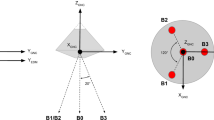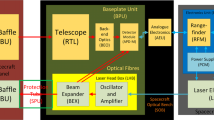Abstract
Among the scientific instruments that will fly on the upcoming mission ASTER, the first Brazilian deep space mission, the laser altimeter will play an important role in the surveys regarding shapes, topographies and masses of the asteroids of the triple system. The development of the instrument in partnership among universities (UNICAMP, UFABC) and companies of the Brazilian aerospace sector is in progress. This paper describes and presents the set of studies that were conducted aiming at the creation of software to embark on the control and signal processing unit of the instrument, with respect to the modeling and simulation of its operation and regarding the emission of laser pulses along with the detection and processing of return pulses. As the main result, a package of computer programs was created to simulate the operation of a pulsed laser altimeter with principle of operation based on the measurement of the pulse time of flight. The simulator software was named ALR_Sim. The results obtained with the ALR_Sim helped to better understand some key features and parameters of the operation of the future instrument, such as the sampling time of the detected signal and the definition of the type of detector suitable for the expected intensity of the return signal. The simulator software was successfully tested with respect to the most common expected situations.







Similar content being viewed by others
References
Abe S, et al. (2006) Mass and local topography measurements of Itokawa by Hayabusa. Science 312(1344). doi:10.1126/science.1126272
de Brum AGV, Hetem A Jr, Francisco CPF, Fenili A, Madeira F, Cruz FC, Assafin M (2011) Preliminary development plan of the ALR, the laser rangefinder for the ASTER deep space mission to the 2001 SN263 asteroid. J Aerosp Technol Manag JATM 3:331–338. doi:10.5028/jatm.2011.03033611
de Brum AGV, Rodrigues AP (2013) Topographic profile of a target with use of laser pulses. A survey directed to the Brazilian deep space mission ASTER. J Phys Conf Ser 46 501 2003. doi:10.1088/1742-6596/465/1/012003
Chapman CR (1995) Near earth asteroid rendezvous: Eros as the key to the \(S\)-type conundrum. In: Proceedings XXVI Lunar Planetary Science Conference, pp 229–230
Cole DT (1998) NEAR laser rangefinder: a tool for the mapping and topologic study of asteroid 433 Eros. Johns Hopkins APL Technical Digest. 19(2)
Macau EEN, Winter OC, Velho HFC, Sukanov AA, de Brum AGV, Ferreira JL, Hetem A Jr, Sandonato GM, Sfair R (2011) The aster mission: exploring for the first time a triple system asteroid. In: Prodeedings of the 62nd International Astronautical Congress, vol 1. Cape Town
Marti K (2005) The BepiColombo laser altimeter—detector characterization and implications for mercury science. Bern University, Thesis work, Bern
Mukai T, Abe S, Barnouin-Jha O, Cheng A (2008) Hayabusa LIDAR. NASA Planetary Data System, 03 Feb 2013. http://sbn.psi.edu/pds/resource/haylidar.html
Shan J, Toth CK (2009) Topographic laser ranging and scanning: principles and processing. CRC Press, Boca Raton, p 590
Sukhanov AA, Velho HFC, Macau EEN, Winter OC (2010) The aster project: flight to a near-earth asteroid. Cosm Res 48:433–450
Yano H et al (2006) Touchdown of the Hayabusa spacecraft at the Muses Sea on Itokawa. Science 312(5778):1350–1353
Yano H, et al. (2012) Planetary protection of Hayabusa-2 mission, a sample return from 1999 JU3, C-type NEO. 2012. Presentation for the NASA Planetary Protection Subcommittee 2012. Available at: http://science.nasa.gov/media/medialibrary/2012/05/04/Hayabusa-2_-_Hajime_Yano.pdf
Author information
Authors and Affiliations
Corresponding author
Additional information
Communicated by Elbert Macau and Cristiano Fiorilo.
Rights and permissions
About this article
Cite this article
de Brum, A.G.V., da Cruz, F.C., Hetem, A. et al. ALR—a laser altimeter for the first Brazilian deep space mission. Modeling and simulation of the instrument and its operation. Comp. Appl. Math. 34, 557–569 (2015). https://doi.org/10.1007/s40314-014-0145-8
Received:
Revised:
Accepted:
Published:
Issue Date:
DOI: https://doi.org/10.1007/s40314-014-0145-8
Keywords
- Deep space mission ASTER
- Asteroid 2001SN263
- Laser altimeter
- ALR
- Modeling and simulation
- Pulsed laser rangefinder
- Simulator software
- ALR_Sim




